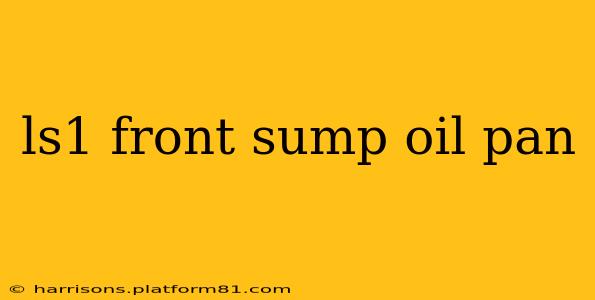The LS1 engine, renowned for its power and versatility, presents a unique challenge when it comes to oil pan selection: the factory front sump design. While functional, the front sump can limit ground clearance and necessitate modifications for certain applications. This comprehensive guide explores the nuances of LS1 front sump oil pans, addressing common questions and concerns. We'll delve into the various options available, their suitability for different projects, and the crucial factors to consider before making a purchase.
What are the advantages and disadvantages of an LS1 front sump oil pan?
The LS1's front sump oil pan, as a factory design, offers some advantages but also presents drawbacks.
Advantages:
- Factory-engineered: Designed and tested by GM to work seamlessly with the engine's lubrication system. This often equates to reliability and consistent performance.
- Cost-effective (generally): Using the stock pan is usually the most affordable option, especially when starting with a complete engine.
Disadvantages:
- Ground clearance: The front-mounted sump can significantly reduce ground clearance, making it unsuitable for low-riding vehicles or off-road applications.
- Accessibility: Accessing the oil pan for servicing can be more challenging in some vehicle installations due to its position.
- Limited capacity: Stock pans often have a smaller capacity compared to aftermarket options, potentially requiring more frequent oil changes in high-performance applications.
What are the different types of LS1 front sump oil pans available?
The market offers a variety of LS1 front sump oil pans, each catering to different needs and applications.
- Stock replacement pans: These are direct replacements for the factory pan, offering similar capacity and dimensions. They are a good option for maintaining a stock appearance and functionality.
- High-capacity pans: Designed for increased oil volume, these are ideal for high-performance applications or extended periods of high-RPM operation, minimizing oil starvation.
- Windage trays: While not strictly oil pans themselves, windage trays are often paired with them, minimizing oil churning and improving lubrication efficiency at high RPM.
Can I use a different type of oil pan (e.g., rear sump) on an LS1?
Swapping to a rear sump oil pan on an LS1 is possible but requires significant modifications. This involves modifying or fabricating a new oil pickup tube, potentially altering the oil pump, and adapting the pan to fit the engine's mounting points. It is a more involved project and not a simple bolt-on solution.
How do I choose the right LS1 front sump oil pan for my application?
Selecting the proper LS1 front sump oil pan depends heavily on your specific needs and intended use. Consider these factors:
- Vehicle application: Will the vehicle see off-road use, track use, or primarily street driving?
- Performance goals: Is the engine stock or modified? Are you aiming for increased horsepower and higher RPMs?
- Budget: Stock replacement pans are more affordable, while high-capacity and specialized pans come with a higher price tag.
- Ground clearance requirements: The front sump's proximity to the ground needs careful consideration, especially in lower vehicles.
What are the common problems associated with LS1 front sump oil pans?
Potential problems with LS1 front sump oil pans include:
- Leaks: Improper installation or damaged seals can lead to oil leaks.
- Oil starvation: In high-performance applications, insufficient oil capacity can lead to oil starvation, especially during hard acceleration or high-RPM operation.
- Damage from impacts: The front-mounted position makes the pan vulnerable to damage from road debris or low-speed impacts.
This guide provides a solid foundation for understanding the intricacies of LS1 front sump oil pans. Remember that careful consideration of your specific needs and application is crucial for selecting the most appropriate option. Consulting with experienced engine builders or mechanics can further enhance your decision-making process.
